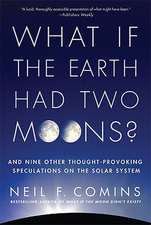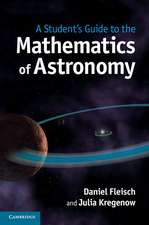Apocalypse When?: Calculating How Long the Human Race Will Survive: Springer Praxis Books
Autor Willard Wellsen Limba Engleză Paperback – 30 iun 2009
Any formula for predicting human survival will invite controversy. Dr Wells counters anticipated criticism with a thorough approach in which four lines of reasoning are used to arrive at the same survival formula. One uses empirical survival statistics for business firms and stage shows. Another is based on uncertainty of risk rates. The third, more abstract, invokes Laplace’s principle of insufficient reason and involves an observer’s random arrival in the lifetime of the entity (the human race) in question. The fourth uses Bayesian theory.
The author carefully explains and gives examples of the conditions under which his principle is valid and provides evidence that can counteract the arguments of critics who would reject it entirely. His deflection of possible criticisms results from two major premises: selecting the proper random variable and “reference class” to make predictions, and the recognition that if one does not know the law that governs a process, then the best prediction that can be made is his own formula.
Din seria Springer Praxis Books
-
 Preț: 294.46 lei
Preț: 294.46 lei -
 Preț: 223.45 lei
Preț: 223.45 lei -
 Preț: 193.12 lei
Preț: 193.12 lei -
 Preț: 167.85 lei
Preț: 167.85 lei -
 Preț: 288.98 lei
Preț: 288.98 lei -
 Preț: 323.74 lei
Preț: 323.74 lei -
 Preț: 401.38 lei
Preț: 401.38 lei -
 Preț: 264.12 lei
Preț: 264.12 lei - 8%
 Preț: 513.00 lei
Preț: 513.00 lei -
 Preț: 190.01 lei
Preț: 190.01 lei -
 Preț: 218.16 lei
Preț: 218.16 lei -
 Preț: 312.06 lei
Preț: 312.06 lei - 17%
 Preț: 414.04 lei
Preț: 414.04 lei -
 Preț: 216.41 lei
Preț: 216.41 lei -
 Preț: 262.27 lei
Preț: 262.27 lei -
 Preț: 264.35 lei
Preț: 264.35 lei -
 Preț: 167.63 lei
Preț: 167.63 lei -
 Preț: 284.81 lei
Preț: 284.81 lei -
 Preț: 259.08 lei
Preț: 259.08 lei -
 Preț: 305.47 lei
Preț: 305.47 lei -
 Preț: 244.14 lei
Preț: 244.14 lei -
 Preț: 227.85 lei
Preț: 227.85 lei -
 Preț: 285.25 lei
Preț: 285.25 lei -
 Preț: 295.56 lei
Preț: 295.56 lei -
 Preț: 357.17 lei
Preț: 357.17 lei -
 Preț: 275.79 lei
Preț: 275.79 lei -
 Preț: 257.08 lei
Preț: 257.08 lei -
 Preț: 349.71 lei
Preț: 349.71 lei -
 Preț: 272.45 lei
Preț: 272.45 lei -
 Preț: 270.27 lei
Preț: 270.27 lei - 8%
 Preț: 456.51 lei
Preț: 456.51 lei -
 Preț: 352.34 lei
Preț: 352.34 lei - 8%
 Preț: 394.80 lei
Preț: 394.80 lei -
 Preț: 320.65 lei
Preț: 320.65 lei -
 Preț: 325.29 lei
Preț: 325.29 lei -
 Preț: 253.11 lei
Preț: 253.11 lei -
 Preț: 192.86 lei
Preț: 192.86 lei -
 Preț: 313.40 lei
Preț: 313.40 lei -
 Preț: 150.51 lei
Preț: 150.51 lei -
 Preț: 233.34 lei
Preț: 233.34 lei -
 Preț: 286.78 lei
Preț: 286.78 lei -
 Preț: 212.01 lei
Preț: 212.01 lei -
 Preț: 366.83 lei
Preț: 366.83 lei -
 Preț: 299.99 lei
Preț: 299.99 lei -
 Preț: 232.27 lei
Preț: 232.27 lei -
 Preț: 284.58 lei
Preț: 284.58 lei -
 Preț: 212.45 lei
Preț: 212.45 lei -
 Preț: 159.81 lei
Preț: 159.81 lei -
 Preț: 349.48 lei
Preț: 349.48 lei - 20%
 Preț: 2061.61 lei
Preț: 2061.61 lei
Preț: 200.13 lei
Nou
Puncte Express: 300
Preț estimativ în valută:
38.29€ • 40.09$ • 31.69£
38.29€ • 40.09$ • 31.69£
Carte disponibilă
Livrare economică 15-29 martie
Preluare comenzi: 021 569.72.76
Specificații
ISBN-13: 9780387098364
ISBN-10: 0387098364
Pagini: 212
Ilustrații: XXVIII, 212 p.
Dimensiuni: 155 x 235 x 12 mm
Greutate: 0.48 kg
Ediția:2009
Editura: Springer
Colecția Praxis
Seria Springer Praxis Books
Locul publicării:New York, NY, United States
ISBN-10: 0387098364
Pagini: 212
Ilustrații: XXVIII, 212 p.
Dimensiuni: 155 x 235 x 12 mm
Greutate: 0.48 kg
Ediția:2009
Editura: Springer
Colecția Praxis
Seria Springer Praxis Books
Locul publicării:New York, NY, United States
Public țintă
Popular/generalCuprins
Formulation.- Confirmation.- Double jeopardy.- Human survivability.- Apocalypse how?.
Recenzii
From the reviews:
“After introducing the reader to key ideas in probability and statistics, Wells starts to develop ideas of probability based first on random-hazard rates … and then ideas based on our own history of survival as a species, and as a civilization. … the book reasonably accessible to the general reader … . The book is well organized, and is written in an easy style … .” (Robert Connon Smith, The Observatory, Vol. 131 (1222), June, 2011)
“After introducing the reader to key ideas in probability and statistics, Wells starts to develop ideas of probability based first on random-hazard rates … and then ideas based on our own history of survival as a species, and as a civilization. … the book reasonably accessible to the general reader … . The book is well organized, and is written in an easy style … .” (Robert Connon Smith, The Observatory, Vol. 131 (1222), June, 2011)
Caracteristici
Provides a unique analysis of the chances of human survivability in the short and long term Develops a formula for survival based on four separate measures Gives the numerical estimates of human survival Substantiates analysis with statistical models of similar processes Shows what is wrong with the existing Doomsday argument and how to fix it












